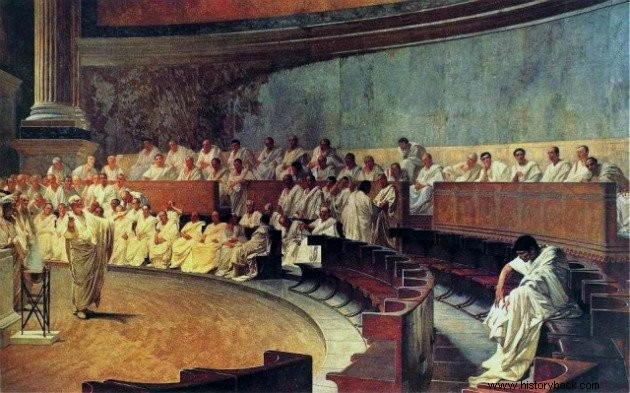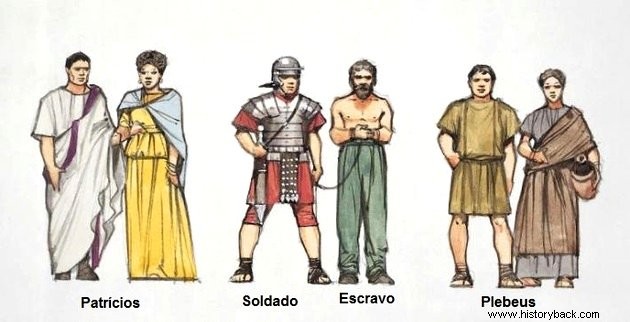The Roman Republic was a period in the history of Roman civilization that spanned 500 years, from 509 BC. to 27 BC when it was ruled by senators and magistrates.
During this time, Rome organized its institutions and made important military conquests that guaranteed its dominion over the Mediterranean Sea.
Origin of the Roman Republic
The Roman Republic has its origin in the year 509 BC, when the last Etruscan king is deposed and the Senate assumes the functions of government.
After the monarchical experience, the Romans chose not to leave power in the hands of a single individual. Therefore, they eliminated the figure of the king and all positions should be held by two or more people.
Thus, there was not the figure of a single ruler, but two, called consuls. These had a term of office of one year and were supposed to control each other.
See also:EtruscansInstitutions of the Roman Republic
- Senate – was concerned with international politics and the supervision of the magistracies and was summoned by the consuls, praetors or the plebeian tribune. It reached 300 members and the position was for life. Senators were patricians who had held a magistracy or had done something relevant to the Republic.
- Magistrature – to be a magistrate it was necessary to be a Roman citizen and to have an income according to the position held. Magistrates had privileged places in public ceremonies and shows, as well as the use of different colors according to their position.
- Consul - exercised military command. In the event of war or the impediment of one of the consuls, they were replaced by a dictator. This one had a one-year mandate and absolute power over Roman citizens.
- Pretor – had the function of administering justice.
- Edil - responsible for supervising trade and running the city.
- Censor – was in charge of counting the population, inspecting the candidates for aedile and monitoring the moral conduct of the Roman people.
- Questor – collected taxes and guarded Roman patrimony.
To learn more about the Romans :
- Roman Civilization
- Roman Emperors
- Roman Gods

Society in the Roman Republic
Roman society was organized between patricians, plebeians, slaves and clients. Women were not considered citizens and did not participate in politics.
Let's see the origin and social function that each extract had:
- Patricians – belonged to the oldest families in Rome, owned large land holdings and were the richest.
- Commoners – Initially, all those who were not patricians and were not slaves were called plebeians. In the beginning they did not have political rights, but because of the corruption scandals of the Senate, little by little they were being co-opted into Roman institutions. As they were the most powerful class, there was great diversity among them. Basically, they were made up of men who had enriched themselves through trade, knights who had made their fortunes from the wars of conquest, medium and small landowners.
- Enslaved – Roman slavery was the basis of society, and both patricians and plebeians had slaves. These were obtained through the wars of conquest. Furthermore, any free man could be enslaved, as debts could be paid with temporary slavery. Not necessarily they always did the worst jobs, as those who could read and write were employed as scribes, accountants, and administrators.
- Customers – commoners who, in order to ascend socially, served a patrician family in exchange for protection and social position.
Patricians x Plebeians
Permanent conflicts between patricians and plebeians will shake the Roman Republic. After all, the Roman army was composed mostly of commoners who were not able to participate in the political life of the city.
In order to pressure the patricians to cede political rights, the plebeians left Rome. They only returned when the creation of the Plebeian Court was negotiated, in 494 BC. He came to control the patricians and the magistracies and, in time, the plebeians would be as powerful as the patricians.
The plebeians were able to organize assemblies and enact laws that guaranteed as many rights as the patricians had. Let's take a look at some of them:
| Assemblies | Popular representative system. There were several forms such as the “comitia curiata” (curial meetings), where the “Lex curiata” was voted on, which were sent to the high magistrates. Later, Sérvio Túlio created the “comitia centuriata”, which consisted of 100 individuals and were essential for military recruitment. |
|---|---|
| Laws of the Twelve Tables – 450 BC | Under pressure from the plebeians, the laws of Rome began to be written so that they were fixed and the plebeians could consult them. |
| Licinian Laws – 376 BC | Determine that one of the consuls must be a commoner. |
| Canulean Laws – 345 BC | Allow commoners to marry patricians. |
Read about Roman Art :
- Roman Painting
- Roman Sculpture
- Roman Architecture
- Rome Colosseum
Military expansion
Once the internal conflict between patricians and plebeians calmed down, the Romans began to conquer other regions of the Italian Peninsula until they completely dominated it.
Then they invaded Greece, from where they brought the gods, philosophy and various customs. They then went to war on the other side of the Mediterranean against the city of Carthage, in a conflict that lasted about 120 years and ended with the Roman victory.
See also:Punic WarsEnd of the Roman Republic
With Roman territorial expansion, the Republic became more difficult to govern due to the inclusion of new peoples and the size.
Likewise, the fragmentation of power did not help in making quick decisions and the practice of corruption had become widespread among the magistrates.
Thus, the Romans sought new formulas that allowed the centralization of power, but always aided (and supervised) by the Senate. First through the Triumvirate and then through the figure of a single Emperor. The time of the Roman Empire would then begin.
See also:Roman Empire
